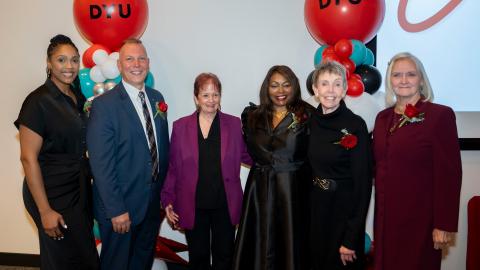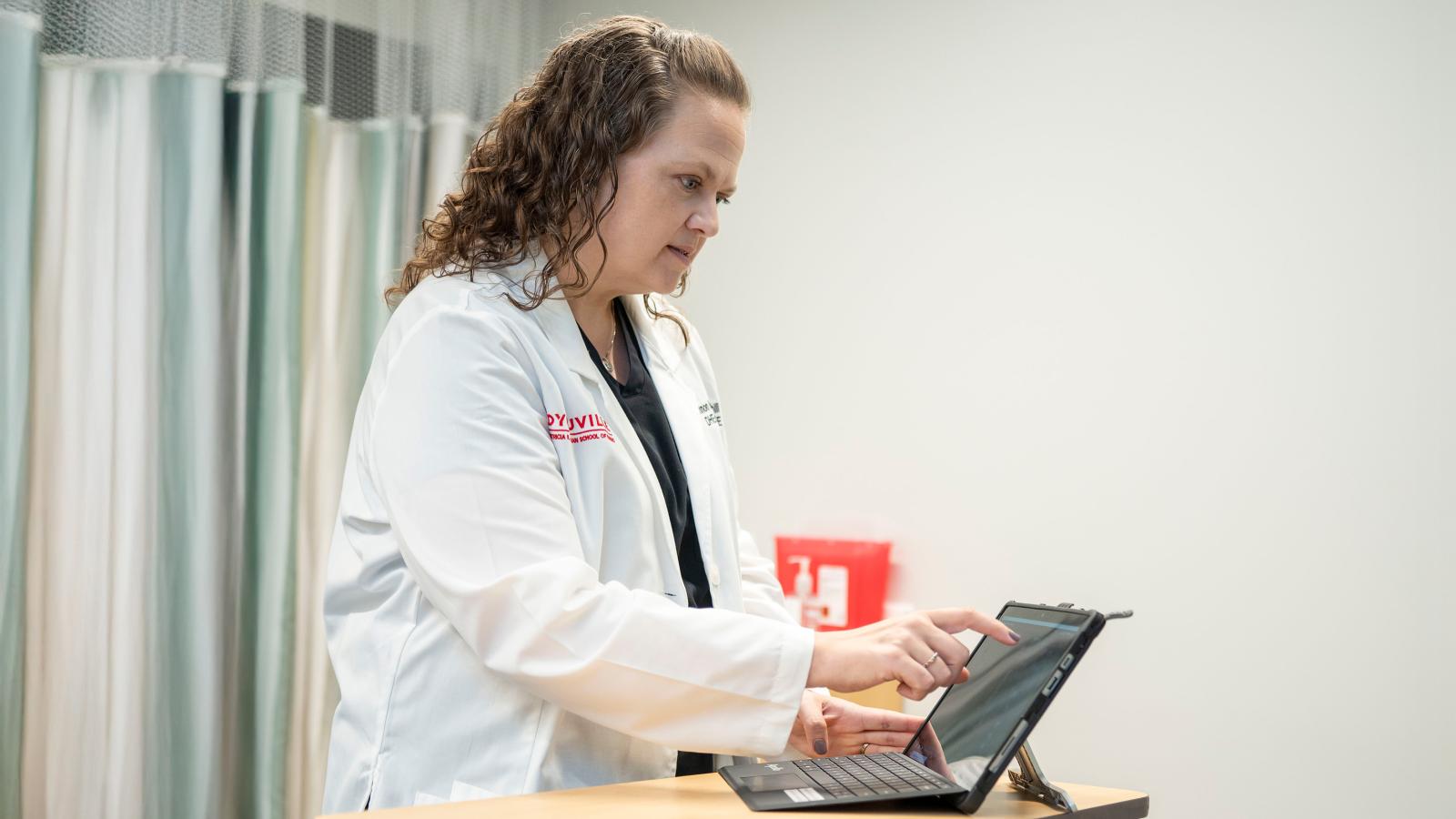
A new College of Medicine is coming to D’Youville – Click here for more.
To Serve a Calling

Nursing was not her first choice. Shannon McCrory-Churchill’s passion was music, and her initial plans for college revolved around that passion. She played several instruments. She was accepted into a prestigious school for music. She would become a professional musician, and one day, she would incorporate her skills into another budding interest — teaching.
Her plan couldn’t be more clear. Until it wasn’t.
Around the time of her high school graduation, McCrory-Churchill’s mother suffered a stroke. Suddenly, she could not leave for college, because she was needed at home. And school had to be something close to home and quick … something she could do while helping in her mother’s recovery. She found nursing, which offered both convenience (a two-year degree) and a career with potential.
She also found her calling.
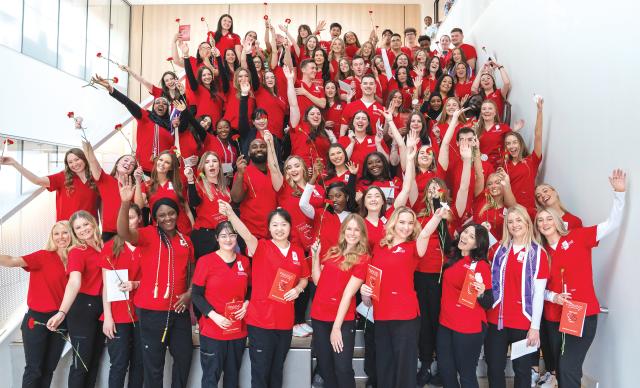
McCrory-Churchill worked in some of the profession’s most difficult settings — pediatric oncology and emergency room being the most demanding, mentally and physically. But in those jobs, her appreciation for the important role nurses have in the “heaviest” of settings grew, and she particularly enjoyed her interactions with students and younger nurses who saw her as a mentor. While working at a children’s hospital, she was approached by a faculty member who suggested she look into becoming an adjunct faculty member in pediatric nursing.
She clearly remembers her job interview to become a clinical associate professor at D’Youville in 2007, and not because it went particularly well.
“I was late for my interview with the then-chair of nursing, because I had a student in the OR, and I wasn’t willing to pull them from their experience so I could go to my interview,” she recalls. “They still hired me, even though I was an hour late. I did call and let her know the reason why, and maybe that helped. But I wasn’t willing to sacrifice their experience for mine.”
McCrory-Churchill worked for 15 years as a professor before becoming acting dean in the summer of 2022. This August, D’Youville “dropped the act” and named her dean of the Patricia H. Garman School of Nursing — D’Youville’s 83-year-old program born from a need for wartime nurses during World War II and growing to become arguably the University’s flagship program and a consistent enrollment draw even in lean years.
Today the School offers three undergraduate programs (BSN, RN to BSN and accelerated BSN), a nurse practitioner master’s program, two doctorate programs (family focus and mental health) and two post-master’s certificates. All programs feature immersive internships and clinical placements, and graduates leave prepared for careers in several healthcare settings — from primary care to hospitals, community and home health to long-term care.
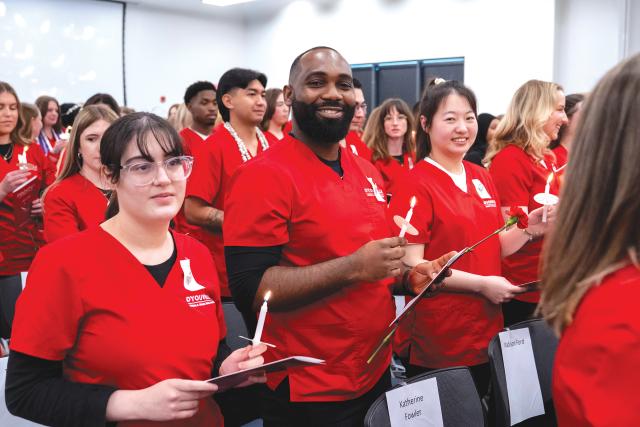
The new dean enters her role in a post-COVID era where the shortage of registered nurses is very real. According to the American Association of Colleges of Nursing, the workforce is expected to expand by 6 percent by 2032, yet 23 percent of current nurses in outpatient, ambulatory and clinical settings have either recently retired or are expected to retire in the next five years. And with the country’s population continuing to live longer (Americans aged 65 and older will increase from 58 million to 82 million by 2050), the need for nurses is expected to remain for years to come.
“I’m reminded that there are a lot of nursing programs in this country [more than 2,600 accredited programs, according to the AACN], but the real question is, ‘Are there going to be a lot of jobs?’ And the answer is yes — that is not something we’re going to have to worry about in the next 20 years and beyond,” says McCrory-Churchill. “There is no possible way — with the current nursing faculty shortage, especially — that this country can even come close in the next 10 years of meeting the need for nurses that we have right now.”
It’s not just a nursing shortage; it’s a provider shortage, she says (the physician shortage alone is expected to hit 86,000 by 2036). Uncertainty with the country’s Medicare program, increased demand due to the aging population and rising chronic diseases and overall post-COVID burnout across all healthcare professions have been contributing factors. McCrory-Churchill says her program is not only providing well-paying careers for its graduates, it’s also contributing to positive health outcomes in Western New York and beyond.
“Hospitals are spending, honestly, millions of dollars on travel nurses [RNs who take on temporary assignments to fill shortages] to fill those gaps,” she says. “We need to find a way in this country to make healthcare less expensive, and one way to do that is by continuing to put out high-quality nurses to fill those roles.”
McCrory-Churchill has been at D’Youville for nearly 20 years, and a lot has changed in the nursing profession and in healthcare since then. Those changes are exciting, but the uncertainties in the profession — government involvement, affordability, to name a few — can be terrifying. D’Youville has to train students who can adapt to change. Students who are “failure-proof.”
“I see my role as a progressive one,” she says. “I have to have a vision for what’s going to happen in the next 10 years and make sure we aim toward that vision before a need arises.”
As a people-person and someone who is very compassionate, nursing seemed like a better fit for me. The majority of bedside interaction in healthcare comes from nurses — and that model of care better fit who I am.
Joshua Peters, 2025 BSN graduate
A good nurse not only impacts a patient, they impact that patient’s loved ones as well. Sidney Domroes was a sophomore in high school when she learned her mother was diagnosed with Stage 2 breast cancer. Sidney was by her side for all of her treatments, her chemotherapy, her radiation treatments and her double mastectomy.
“I wanted to be there, because I felt like I was at that age where I could help out,” says Sidney, a student in D’Youville’s RN-to-BSN accelerated program. “And I remember when I’d go with her to fusion treatments, I’d notice the nurses and how they were caring for her and interacting with her. And it stuck with me.”
Those nurses were there for her mother during her initial bout and have been by her side since her rediagnosis in August 2024 (this time, Stage 4). They’ve gone beyond the bedside and appointment care — they’ve helped her find wigs after chemo, bras following surgery, support groups for her mental health and more.
“I’ve known for a while that I wanted to go into nursing,” says Sidney, who started college at a different school in 2020, but struggled to find a fit in that program as she juggled her schedule, her mom’s schedule and the sudden death of her father in 2023. “I knew that if I wanted to get back into it, I needed an accelerated program, and that’s how I found D’Youville.”
Joshua Peters grew up in Rochester in a family of healthcare professionals — his mom is an EMT and his uncle is a doctor. He decided to follow in their footsteps in college and took courses to prepare for medical school. But a job as a patient care technician at a hospital in Rochester revealed what it was about healthcare that Joshua was drawn to in the first place — the people. After finishing his four-year degree in psychology at another school, Joshua sought nursing programs that offered an accelerated path to a BSN, and he found that at D’Youville. He started the program in May of 2024 and graduated this past August after 15 months.
“From the beginning, I was drawn to the nursing side of medicine and care,” he says. “As a people-person and someone who is very compassionate, nursing seemed like a better fit for me. The majority of bedside interaction in healthcare comes from nurses — and that model of care better fit who I am.”
McCrory-Churchill points to students like Sidney Domroes and Joshua Peters as classic examples of why students are drawn to nursing — reasons that aren’t much different than the seven who made up D’Youville’s first class in 1942.
“Being a nurse really puts you closer to the action than being a physician or a physician assistant,” she says. “The role is hands-on and personal. It’s a caring role, and the caring philosophies and all of the nursing theorists will tell you — that piece of it makes it so much different from the other professional models, and that’s what attracts people to it.”
Nursing is the nation’s largest healthcare profession with nearly 4.7 million registered nurses nationwide. The median age of nurses in the U.S. is 46 years old, and while the majority of nurses continues to be women, the percentage of men in the field continues to grow (up to 11 percent in 2022). Registered nurses comprise one of the largest segments of the nation’s workforce as a whole, and more than half of all RNs work in general medical and surgical hospitals, earning an average salary of $77,600 a year, according to the Bureau of Labor Statistics.
As for what nurses do, that answer varies greatly. Most healthcare services involve some form of care from nurses — they’re in high demand in every sector of the industry, from hospitals to private practices, schools to mental health agencies, and hospice and nursing homes to military agencies. While many view the profession as an “assistant” to physicians and other patient-facing professionals, nurses often operate independently.
According to the American Association of Colleges of Nursing, there are four times as many RNs in the U.S. as there are physicians.
The many paths a nurse can follow are covered in D’Youville’s curriculum, according to McCrory-Churchill. The program also doesn’t gloss over the potential negatives of the profession — nursing can be a physically and mentally demanding career, and burnout is a serious concern within the industry. More than a quarter of current nurses report they plan to leave nursing or retire in the next five years, and 62 percent of current nurses say they experienced high levels of stress in their job in 2025 (that number jumps to 69 percent for those under 25).
“There is a common saying in the profession: ‘Nurses eat their young.’ We stay away from that. It is a demanding profession, and [students] have to be prepared for the fact that it’s not going to be an easy road, because sometimes things worth doing aren’t easy,” McCrory-Churchill says. “You have someone’s life in your hands. You need to do what the patient needs you to do, when the patient needs it. Some demands are reasonable, and some aren’t. Nursing is a calling. It’s something you don’t do if you don’t love it. And those who love it stay with it, and they find a lot of fulfillment in it.”
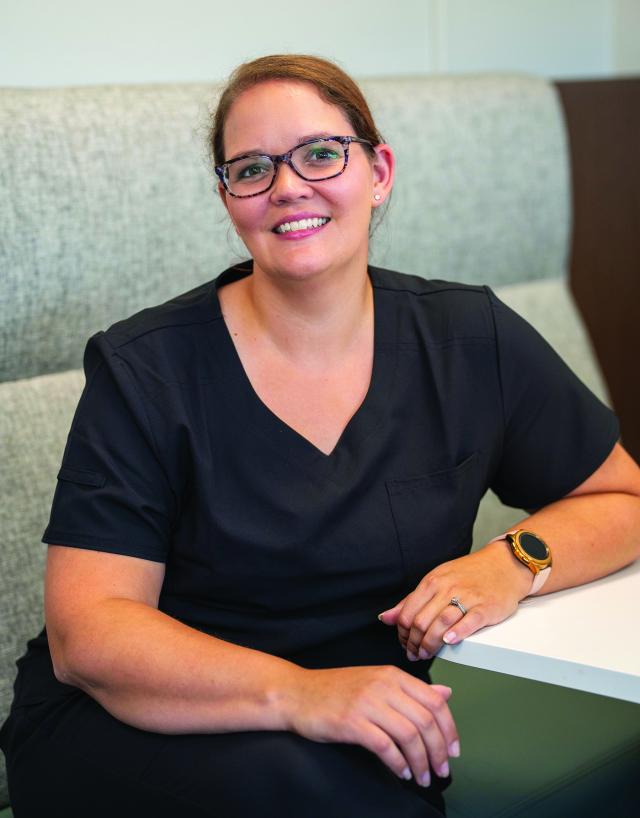
Phoebe has gone into labor in one room. Monica is complaining about chest pains in another. And could Chandler be more vague about his symptoms in Room 3?
The high-tech mannequins in D’Youville’s nursing simulation lab share the names of the staff’s favorite Friends characters, but unlike their television counterparts, these fictional people have very clear jobs — to throw out any possible scenario (from the routine to the rare) at students to help them prepare for the real thing once they graduate.
D’Youville’s new state-of-the-art nursing simulation center — located on the fourth floor of the Dr. Pauline M. Alt Building — was designed to fully immerse nursing students in the hospital environment and includes a nursing station to allow students to carry out scenarios outside of the patient room. The lab is equipped with 360-degree cameras to monitor students, ICU-style bays, those fully functional high-fidelity mannequins and simulation scenarios written by faculty and clinicians who work in the field.
The center is overseen by Dr. Amanda Barton, director of nursing simulation and clinical practice, who says the average D’Youville nursing student will see around 33 total simulations and 100 hours in the lab by the time they graduate. Roughly a third of their clinical time is spent in simulation.
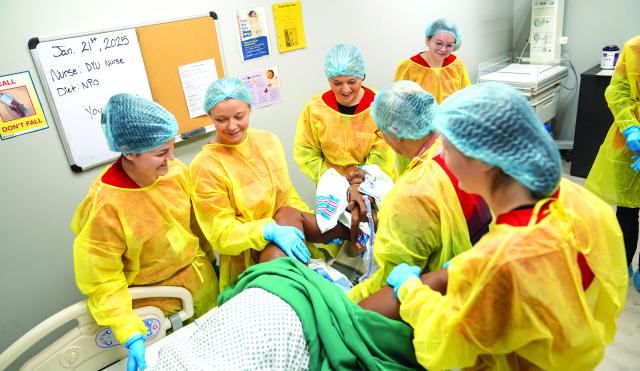
“They start with the basics here, like making a bed with a patient in it or communicating with a patient and their family,” Barton says. “And we work all the way up to our senior level, like caring for an intubated patient. We have ventilators set up. Multiple drugs set up. Even the simulated fentanyl is in a lockbox — we try really hard to make things as realistic as possible.”
Adding to the realism is the Friends cast, made up for full-body high-tech patient mannequins that bring realism in the form of a pulse, breathing simulations, the ability to bleed and urinate and speech (provided by faculty and supervisors in the control room).
“He blinks, he breathes, his chest can rise and fall, he has a pulse everywhere you an have a pulse, he has lung and bowel sounds, and you can put a tube in him anywhere you would put a tube in a patient,” Barton says, standing over “Chandler” in one of the patient bays. Each patient runs the department $80,000 and up, not including the equipment surrounding it.
The beds, the machines, the lighting and even the paint schemes, floor tiles, the smells and even the molding along the floors and ceilings are all as close to the real thing in a hospital as you can get, but perhaps the most impressive detail of the lab is the nurses station at the center of it all. For anybody who’s spent any time in a hospital recently, the station is familiar — cabinets, desks, space for records, bulletin boards, phones, medicine storage … it has it all. It’s the spot where a nurse will spend most of their time during a hospital shift, and a big part of a student’s simulation experience at D’Youville is spent at that station.
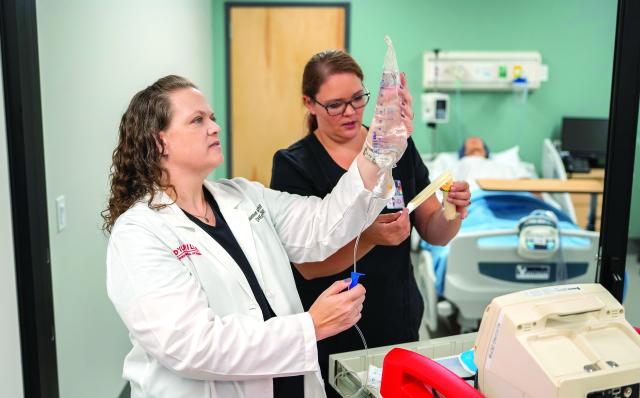
“What happens if a bipolar patient gets out of their room and approaches your station? What do you do? Who else is there to help? What is everybody’s role?” Barton says. “We even work on things like calling providers and calling labs to get patient information. How to approach your charge nurse to ask for help. So much happens here. It’s important that we are able to recreate all of that.”
When she was a student, Barton says her first experience with patients, real or fake, was in a hospital, where there is little time for a new nurse to “ease into” their new settings. The reality, she says, is that nurses are often just thrown into the fire — practicing the possibilities before they happen can lead to better outcomes for everyone. The patient is better served, and the nurse is more sure of themselves and less stressed in those important early years of their profession.
“This is a place where they can and do make mistakes,” Barton adds. “And it’s OK to do that. It’s OK to have fun in this setting. We want them to relax. We want them to know you’re not going to hurt this mannequin if you do something wrong. But if you do something wrong, we’re going to talk about it and learn from it. And guess what? You’ll never do it again. Do it here. Don’t do it out there.”
The lab is just one of the selling points of the now 83-year-old nursing program at D’Youville, McCrory-Churchill says. She also points to smaller class sizes that allow students to interact face-to-face with their professors and not come in “feeling like a number.” She also says students appreciate the options, such as the school’s Family Nurse Practitioner master’s program designed to prepare registered nurses to care for individuals across the lifespan and lead to eligibility for FNP board certification. The Psychiatric Mental Health Nurse Practitioner master’s program and the Doctor of Nursing Practice program prepare students to take leadership roles on their teams.
And D’Youville’s involvement in New York’s Career Pathways Training Program — which offers free tuition and covers fees and supplies for those pursuing healthcare degrees in nursing, mental health counseling, physician assistant, pharmacy technician and other areas — has led to a large influx of students who may not have otherwise been able to afford a four-year undergraduate program.
“Nursing isn’t going to disappear. AI isn’t going to take our jobs,” McCrory-Churchill says. “Nurses have been taking on more progressive roles in terms of driving care in our system, and I think that’s why the four-year BSN [and graduate programs] are so important. There’s absolutely nothing wrong with having a two-year RN degree — they come out incredibly prepared and really well-suited to do the roles that they’re in. But in terms of management and patient care and moving things forward, you need the four-year degree. And that’s where D’Youville really shines.”
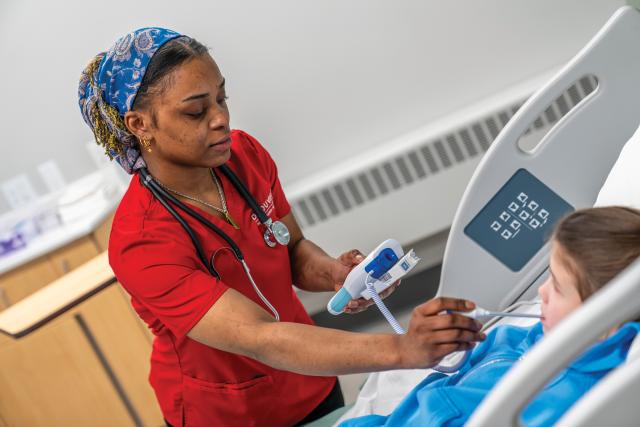
Sidney Domroes says she wishes D’Youville would have been her first choice as an undergraduate, but she’s happy to be in the accelerated BSN program and enjoys the one-on-one opportunities she has with her professors. “I feel like they really care for us and want to see us do our best. I recently had a situation before one of my exams where I had a panic attack, and that affected my performance. I met with two professors, and they understood my situation. They referred me to counseling services on campus and helped me through a difficult situation.”
Joshua Peters — who encouraged his classmates to advocate for their patients, their teams and themselves during his pinning ceremony speech this year — said he came to D’Youville with a lot of self-doubt about his abilities and his future.
“Being able to get through this difficult program has shown me a lot. I know I can do it now, and now I can move forward and work toward becoming a nurse practitioner. There’s a whole new set of challenges coming up, but I’m more confident about them now. D’Youville showed me I can handle it, and I’m glad I came here.”
—---------------------
PATRICIA H. GARMAN (’76 BSN)
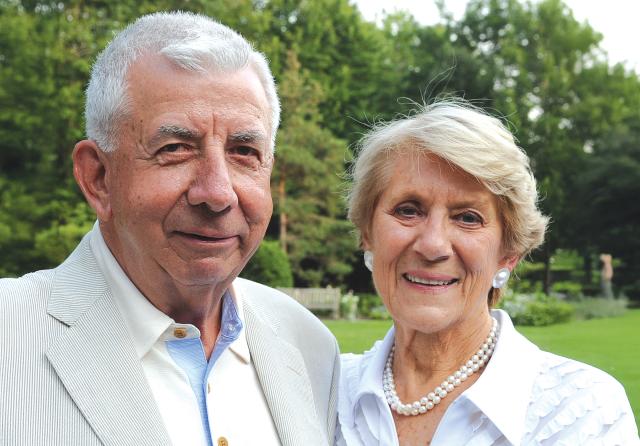
Patricia H. Garman was born in Selinsgrove, Penn., and earned a degree to become a registered nurse at Georgetown Medical Center of Temple University. After taking time off to raise her family, she returned to school in 1973 and earned a bachelor’s degree in nursing at D’Youville and, later, a master’s degree in psychiatric nursing at the University of Buffalo. She became part of the faculty team at DYU in 1977 and taught psychiatric nursing until 1985.
She and her husband Richard were advocates for nursing education in Western New York and generous supporters of D’Youville University and the University of Buffalo, her two alma maters. In 2017, the Garmans donated $2 million to D’Youville to name the School of Nursing after Patricia. The gift, at the time, marked one of the largest one-time gifts to the school and resulted in the continuation, expansion and strengthening of the nursing department.
“Pat Garman chose to pursue a career in nursing at D’Youville for an opportunity to serve the health, education and welfare needs of the community,” President Dr. Lorrie Clemo said at the naming ceremony in 2017, three years after Garman’s death. “This gift honoring her legacy as an alumna and faculty member of the school will place her memory and the Garman name in a tradition of those who have established, nurtured and articulated a vision for a college of the future.”
While she taught at D’Youville, Garman started Counseling Specialists (a business that focused on families and children), using her knowledge and experience to provide comprehensive care to individuals, families and children dealing with mental illness, addiction and other struggles.
As a nurse, Garman’s strong therapeutic relationships with individuals transformed lives in a positive way.

